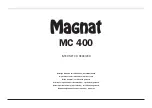
SPECIFICATIONS:
Frequency
Range
135
–
141MHz
Input
Sensitivity
0.223uV
for
12dB
SINAD
-120dBm
Bandwidth
1st IF 10.7MHz 230kHz BW @ 3dB
2nd IF 455kHz 30kHz BW @ 6dB
Frequency
Tuning Varicap
Tuned
VCO
with
AFC
circuit
&
Temperature compensation.
Optional External PLL Synthesizer.
Audio
Output
Speaker
Output
8
to
32ohms
up
to
500mW
PC
Audio
Output
Filtered
for
connection
to
a
sound card 2v p-p
Power
+12vdc 100mA
DESCRIPTION:
Updated April 2011 to use the replace-
ment BF998R MesFET. The complete Weather Satellite
Receiver is built on a single 95 x 80mm size PC board &
takes around 4 hours to construct. The receiver is designed
around Motorola’s MC13135P double conversion superhet
receiver IC. The IC contains a complete receiver & has a
dual conversion IF, two local oscillators & FM
demodulator. The internal Varicap diode is used on the
first local oscillator for frequency tuning. The circuit board
has been designed for easy connection of an optional PLL
Synthesizer for tuning, & 10.7MHz wideband FM IF
demodulator for WEFAX reception on 1691MHz.
RECEIVER DESIGN:
It took many months collecting
information on Weather Satellite reception & receiver
design, before I had some idea of what was required. The
following is a wish list for a receiver design.
1/ Low cost single board design self contained re
ceiver just plug in an antenna & connect to the
computers
sound
card.
2/ Simple single chip FM receiver design with a low
component
count.
3/ PLL synthesizer to allow scanning of the Weather
Satellite frequencies, & a mute circuit to stop scan
ning
automatically.
4/
Receiver
IF
Bandwidth of 40kHz @ 3dB.
5/ PLL FM demodulator to track the IF for Satellite
doppler
shift.
6/ Separate adjustable audio output suitable for direct
connection to a computers sound card.
7/ Good receiver sensitivity but able to reject adjacent
channel interference & overload from pagers &
Orbcomms.
8/ Able to be used or modified for use with a
1691MHz
downconverter
for
WEFAX.
Most of the above has been achieved except the use of a
PLL Synthesizer which can be an additional option. A
clever way of tracking doppler shift with a reduced IF
bandwidth requirement has been adoptod, & will be
explained in the circuit description. Most designs use
either the dual conversion MC3362P or MC13135P
Motorola chips as a complete FM receiver. I decided on a
dual conversion FM receiver design using the Motorola
MC13135P chip as the MC3362P was found to be obsolete.
It seems that the MC13135P has recently suffered the same
fate, but there are still plenty available worldwide. The
most important design issue was the IF bandwidth
requirement of the receiver. The only known problem with
a dual conversion design is getting enough bandwidth from
the second IF of 455kHz. Most articles indicated that a
bandwidth of at least 30kHz @ 3dB was required, &
preferably 40kHz @ 3dB to accommodate up to +/- 3kHz
doppler shift. Suitable filters were looked at for 10.7MHz
& 455kHz. The cost was the main consideration, so
ceramic filters were the preferred over high cost crystal
filters. After checking suppliers I finally found some 50kHz
@ 3dB wide 10.7MHz filters in a large quantity. The
455kHz filters were found to be easier to obtain & the
widest bandwidth available was 30kHz @6dB. This is
possibly a little narrow but seems to be the widest available
in 455kHz filters, & have been commonly used in weather
satellite receiver designs for 137MHz. It was only found
out when the prototype receiver was built, that the 50kHz
filters were not usable due to the tolerance of the center
frequency of the filters, & the 10.245MHz computer
crystals. This caused the down mixed IF frequency to be
slightly off 455kHz, & in combination with the 455kHz
filter the 30kHz BW was much reduced. It was then
discovered to get around the problem, most designs used a
wide band 280kHz 10.7MHz filter for the first IF, which
does not seem to affect the performance with the 455kHz
filter doing most of the work. I have opted to use a slightly
narrower 230kHz wide filter as these were easy to obtain.
CIRCUIT DESCRIPTION:
Refer to the circuit diagram.
The antenna input signal passes through the input tuned
circuit & is amplified by the BF998R MesFET. The output
is then filtered by a 3 stage 135 to 141MHz bandpass filter.
The filter effectively removes unwanted signals outside the
passband including pager interference on 150MHz before
being input to pin 22 of the MC13135P IC. The input
signal on 137.500MHz is mixed with a free running Voltage
Controlled Oscillator, VCO on 148.200MHz to produce a
10.7MHz IF output on pin 20. The VCO consists of the
.COM.AU
137MHz Weather Satellite Receiver
EME117 Ver3
Mini
kits
®
Copyright
©
Mini-Kits
www.minikits.com.au
Revised
17/11/2014
DISCONTINUED
PRODUCT

























